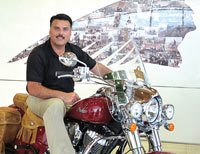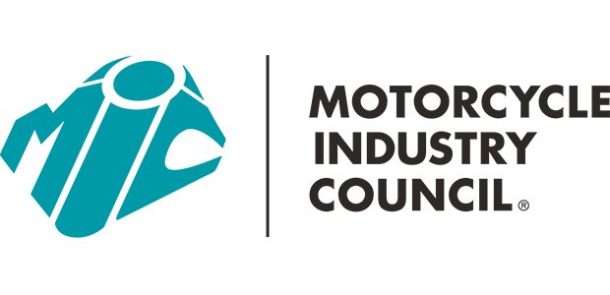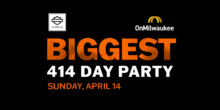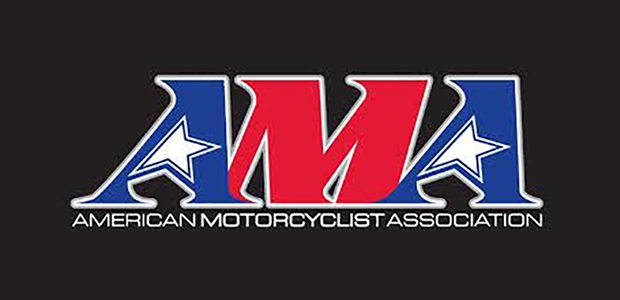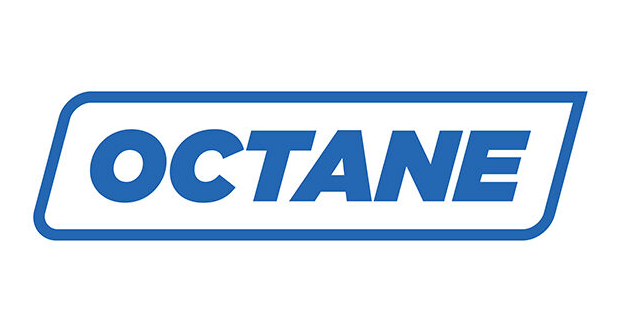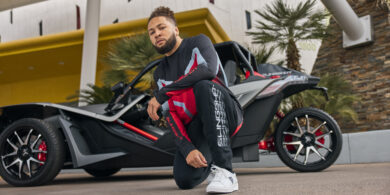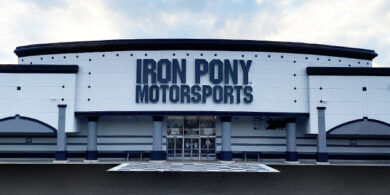2014 Powersports Business Industry Leader – Steve Menneto
2014 Powersports Business Industry Leader
Steve Menneto
Vice President, Motorcycles
Polaris Industries
From Polaris’ purchase of the iconic Indian Motorcycle brand in 2011 to the unveil of the new Thunder Stroke 111 engine last year at Daytona Bike Week to the Indian re-launch at Sturgis last summer, Steve Menneto has chalked up his share of accomplishments over the past few years. As vice president of motorcycle brands Indian and Victory for Polaris Industries, Menneto’s growing list of achievements continued earlier this year, when he was elected to the Motorcycle Industry Council board of directors. Throw in the receipt of the V-Twin Expo Industry Leader of the Year for 2014, and there’s no doubt that Menneto’s accomplishments are worthy of 2014 Powersports Business Industry Leader status.
Menneto’s powersports blood has run in his 20 years in the industry, beginning with his successful Menneto Powersports dealership operation in upstate New York. His tenure at Polaris has included stints as director of North America sales and general manager of Victory Motorcycles, all prior to becoming VP of Motorcycles in 2009.
But the Indian re-launch, both a once-in-a-lifetime experience and still a work in progress at the retail level, particularly needed Menneto’s attention over the past several years. Here, he shares his insight about Indian and the industry in general.
What is the biggest opportunity for the industry, and how can the industry take advantage of it?
I think the biggest opportunity for the industry is recruiting new riders. In 2013, our industry in North America finished at half the size it was in 2007. There are many reasons for the decline, including fewer OEMs, economic challenges and aging rider demographics. However, the biggest opportunity for the industry is to attract new riders of all ages. Motorcycle riding is fun — there is a great social aspect to it, and it allows you to discover places, people and experience. Millennials today crave those experiences, but as a group they have yet to recognize motorcycle riding as a way to serve their interest in exploration. Our industry has to do a better job of communicating the benefits of this tremendous lifestyle.
How we do it, is by OEMs and dealers promoting safe riding through rider safety courses. We can recruit through local ride clubs and outreach programs. Social media is a great medium to promote motorcycling, giving riders a chance to promote their lifestyle to interested yet hesitant non-riders. Growing the category is our biggest opportunity and we all have to work together to make it happen.
What has been the biggest challenge in your current position and how have you dealt with it?
Building the Indian Motorcycle business from the ground up has been the biggest challenge. We are still in the beginning stages as we approach our first year after the launch of the new 2014 Indian Chiefs. We acquired the business in April 2011 and we had to build everything from scratch: A new team, new bikes, new apparel and accessories, new supply chain, new dealer network, new marketing plans and so on. Everything was new and we were working against the clock. We knew that if we delayed too long and the brand became idle, we risked losing the riding community’s interest in the brand after the acquisition. While we had to execute in a short period of time, we also had to balance customer expectations, quality and costs vs. speed. We dealt with — and still deal with it — by being customer-centric in our decisions. We have one chance to get it right and build a great, enduring business. Making sure we think about satisfying our customer is core to our strategy.
What is the best advice that you can give others in the industry?
I think our industry does an outstanding job of making compelling products. The best advice I could give is to put as much effort and focus on people and process. The Indian acquisition and launch required the entire Polaris team’s collective efforts. We have great people working on the Indian Motorcycle business directly and supporting us indirectly. It begins with senior leadership support and commitment to the end goal, like the support we received from the board and Scott Wine (CEO) and Bennett Morgan (COO). We have exceptional people on our engineering, operations, international, HR, finance, sales and marketing teams, who all played a huge role in the success of Indian. We were supported indirectly by the great people in our ORV, International, PGA and Snow businesses, whose profitability allowed us to invest in Indian Motorcycle and not cut corners. It’s a terrific story of how all the people in your company can really have an impact on a growth initiative or new business.
We also focused on our processes right from the beginning. As an organization, Polaris is committed to becoming a Lean Enterprise and we applied Lean Production Tools to our processes as we built the Indian Motorcycle product and business. The more waste you can remove from your processes and the more value added to the customer, the more successful your organization can become.
The turnaround time from paper to production for the Indian lineup was incredible. Looking back on it, what were the best leadership traits that made the launch come to fruition?
Clarity and perseverance — As you could imagine, we had numerous decisions to make under the pressure of balancing customer expectations, quality, cost and speed. Providing clarity and timely feedback were vital to allow all the teams to hit their goals on time. As a team, we faced many roadblocks and challenges that we could’ve succumbed to or been sidetracked by, if we had allowed it. The perseverance of the entire team was really the significant trait that helped us make the launch happen.
You’ve worked your way up from being inside the dealership to operating the motorcycle division of one of the most successful companies in the industry. What were the key ingredients for your own personal success that you picked up along the way? What would you tell someone who was in your same shoes at the dealership level, in terms of reaching their goals, whether it’s a service employee or a multi-store owner? How can they challenge themselves to go where you have gone and do what you have done?
I’ve been fortunate to work for an exceptional company like Polaris, who provides a lot of opportunity to their employees. I think the key ingredients are performing with a high “say/do” ratio, bringing innovative thinking to your roles and being willing to take tough assignments. If you set challenging goals and hit them, add value to your organization through new ideas, offer a new approach to business challenges, and don’t shy away from risky assignments, you can succeed in your career or business.
How did the challenge of launching Indian rank with some of the other tasks you’ve faced with Victory, and how did you build off your experience of guiding the Victory brand to Indian’s launch success?
The launch of the Indian brand was different to the Victory business on the surface, but very similar behind the scenes. It was different because Indian was a recognizable 100-plus-year-old brand with a reasonable quality, high-priced bike when we acquired it and Victory was a 15-year-old brand still gaining recognition with industry-leading quality and competitively priced. They were similar in the business aspect. When we took over the Victory business in May 2009 we had to turn the business around and get it growing again. By 2012, we tripled the Victory business and doubled the global dealer base by focusing on bettering the business. Improvements included introducing brand management and requiring specific in-store branding; our lean production system called RFM; new and high-quality apparel and accessories; increased engineering know-how applied to products; enhanced operations capabilities; our international team’s execution, with Victory making incremental strides each year, Indian benefitted by being launched to a global audience with brand discipline and consistency and finally, Polaris’ relentless focus on retail. We’ve applied the learnings gained from the Victory turnaround to the Indian business to accelerate our performance and drive toward fast success.
I would imagine the Thunder Stroke 111 has a pretty special place among your list of accomplishments. Why was that new engine so important to develop, and how important was it to the Indian brand?
The Thunder Stroke 111 is the crown jewel of these majestic bikes. It is simply indispensable to the brand on four levels. The Thunder Stroke 111 ties the history and future of the brand together, by taking the styling cues of our past with the same finning as earlier Chiefs, air-cooling, parallel push rods and straight-down exhaust and the power and torque of our modern engine. Second, it means that Indian isn’t using a Victory Freedom engine, the Kings Mountain Engine or the S&S engine, it was clearly its own engine born of its past and powering it future. Third, it showed Polaris was serious about being stewards of the Indian brand and we are investing in its future for the long run. Finally, it is an extremely beautiful and powerful engine that shows riders and competitors that Indian Motorcycle is a formidable motorcycle company.
What are some of the most important things that current and prospective dealers should know about retailing the brand, and about the build-outs and CRMs in particular?
Dealers and prospects should know that Indian Motorcycle is one of the most exciting opportunities in the powersports industry today. Our approach to new products and service will deliver growth for the right dealers. We specify a white-glove branding package that can be constructed in an existing or new facility. The Media Hearth helps tell the rich and expansive story of Indian’s history and heritage, as well as provides a customizable marketing tool for the dealer. We are working with multi-line dealers who are willing to commit to a store-within-a-store inside their existing dealerships. Customer experience is an extremely important piece of the Indian dealer requirement, and if dealer prospects currently do not have a CRM system we will work with them to create that capability in their store.

